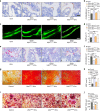Extracellular vesicles from human urine-derived stem cells prevent osteoporosis by transferring CTHRC1 and OPG
- PMID: 31263627
- PMCID: PMC6594995
- DOI: 10.1038/s41413-019-0056-9
Extracellular vesicles from human urine-derived stem cells prevent osteoporosis by transferring CTHRC1 and OPG
Abstract
Osteoporosis is a debilitating bone disease affecting millions of people. Here, we used human urine-derived stem cells (USCs), which were noninvasively harvested from unlimited and easily available urine, as a "factory" to obtain extracellular vesicles (USC-EVs) and demonstrated that the systemic injection of USC-EVs effectively alleviates bone loss and maintains bone strength in osteoporotic mice by enhancing osteoblastic bone formation and suppressing osteoclastic bone resorption. More importantly, the anti-osteoporotic properties of USC-EVs are not notably disrupted by the age, gender, or health condition (with or without osteoporosis) of the USC donor. Mechanistic studies determined that collagen triple-helix repeat containing 1 (CTHRC1) and osteoprotegerin (OPG) proteins are enriched in USC-EVs and required for USC-EV-induced pro-osteogenic and anti-osteoclastic effects. Our results suggest that autologous USC-EVs represent a promising novel therapeutic agent for osteoporosis by promoting osteogenesis and inhibiting osteoclastogenesis by transferring CTHRC1 and OPG.
Keywords: Osteoporosis.
Conflict of interest statement
Competing interestsThe authors declare no competing interests.
Figures







References
LinkOut - more resources
Full Text Sources

